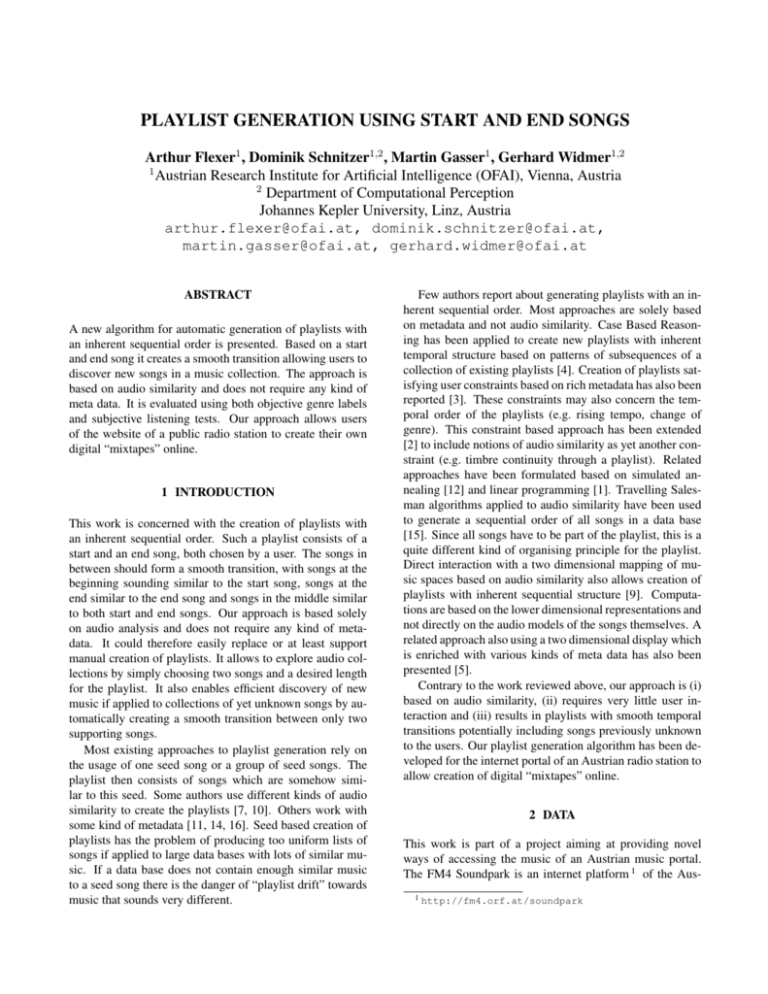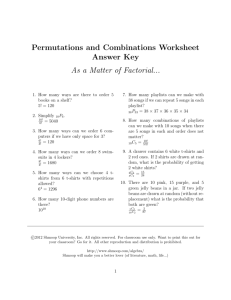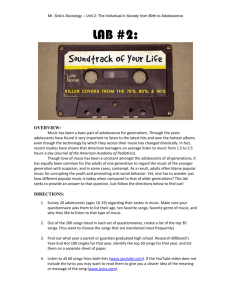PLAYLIST GENERATION USING START AND END SONGS
advertisement

PLAYLIST GENERATION USING START AND END SONGS Arthur Flexer1 , Dominik Schnitzer1,2 , Martin Gasser1 , Gerhard Widmer1,2 1 Austrian Research Institute for Artificial Intelligence (OFAI), Vienna, Austria 2 Department of Computational Perception Johannes Kepler University, Linz, Austria arthur.flexer@ofai.at, dominik.schnitzer@ofai.at, martin.gasser@ofai.at, gerhard.widmer@ofai.at ABSTRACT A new algorithm for automatic generation of playlists with an inherent sequential order is presented. Based on a start and end song it creates a smooth transition allowing users to discover new songs in a music collection. The approach is based on audio similarity and does not require any kind of meta data. It is evaluated using both objective genre labels and subjective listening tests. Our approach allows users of the website of a public radio station to create their own digital “mixtapes” online. 1 INTRODUCTION This work is concerned with the creation of playlists with an inherent sequential order. Such a playlist consists of a start and an end song, both chosen by a user. The songs in between should form a smooth transition, with songs at the beginning sounding similar to the start song, songs at the end similar to the end song and songs in the middle similar to both start and end songs. Our approach is based solely on audio analysis and does not require any kind of metadata. It could therefore easily replace or at least support manual creation of playlists. It allows to explore audio collections by simply choosing two songs and a desired length for the playlist. It also enables efficient discovery of new music if applied to collections of yet unknown songs by automatically creating a smooth transition between only two supporting songs. Most existing approaches to playlist generation rely on the usage of one seed song or a group of seed songs. The playlist then consists of songs which are somehow similar to this seed. Some authors use different kinds of audio similarity to create the playlists [7, 10]. Others work with some kind of metadata [11, 14, 16]. Seed based creation of playlists has the problem of producing too uniform lists of songs if applied to large data bases with lots of similar music. If a data base does not contain enough similar music to a seed song there is the danger of “playlist drift” towards music that sounds very different. Few authors report about generating playlists with an inherent sequential order. Most approaches are solely based on metadata and not audio similarity. Case Based Reasoning has been applied to create new playlists with inherent temporal structure based on patterns of subsequences of a collection of existing playlists [4]. Creation of playlists satisfying user constraints based on rich metadata has also been reported [3]. These constraints may also concern the temporal order of the playlists (e.g. rising tempo, change of genre). This constraint based approach has been extended [2] to include notions of audio similarity as yet another constraint (e.g. timbre continuity through a playlist). Related approaches have been formulated based on simulated annealing [12] and linear programming [1]. Travelling Salesman algorithms applied to audio similarity have been used to generate a sequential order of all songs in a data base [15]. Since all songs have to be part of the playlist, this is a quite different kind of organising principle for the playlist. Direct interaction with a two dimensional mapping of music spaces based on audio similarity also allows creation of playlists with inherent sequential structure [9]. Computations are based on the lower dimensional representations and not directly on the audio models of the songs themselves. A related approach also using a two dimensional display which is enriched with various kinds of meta data has also been presented [5]. Contrary to the work reviewed above, our approach is (i) based on audio similarity, (ii) requires very little user interaction and (iii) results in playlists with smooth temporal transitions potentially including songs previously unknown to the users. Our playlist generation algorithm has been developed for the internet portal of an Austrian radio station to allow creation of digital “mixtapes” online. 2 DATA This work is part of a project aiming at providing novel ways of accessing the music of an Austrian music portal. The FM4 Soundpark is an internet platform 1 of the Aus1 http://fm4.orf.at/soundpark No. % HiHo 226 9 Regg 60 2 Funk 56 2 Elec 918 36 Pop 158 6 Rock 1148 45 Table 1. Number of songs and percentages across genres in our data base. Genres are Hip Hop, Reggae, Funk, Electronic, Pop and Rock. trian public radio station FM4. This internet platform allows artists to present their music free of any cost in the WWW. All interested parties can download this music free of any charge. At the moment this music collection contains about 10000 songs but it is only organised alphabetically and in a coarse genre taxonomy. The artists themselves choose which of the six genre labels “Hip Hop, Reggae, Funk, Electronic, Pop and Rock” best describe their music. We use a development data base of 2566 songs for our experiments. Number of songs and percentages across genres are given in Tab. 1. The distribution of genres is quite unbalanced with “Electronic” and “Rock” together taking up 81%. This is representative of the full data base. From the 22050Hz mono audio signals two minutes from the center of each song are used for further analysis. We divide the raw audio data into non-overlapping frames of short duration and use Mel Frequency Cepstrum Coefficients (MFCC) to represent the spectrum of each frame. MFCCs are a perceptually meaningful and spectrally smoothed representation of audio signals. MFCCs are now a standard technique for computation of spectral similarity in music analysis (see e.g. [6]). The frame size for computation of MFCCs for our experiments was 46.4ms (1024 samples). We used the first 20 MFCCs for all our experiments. 3 METHODS 3. compute a similarity matrix between all songs using the Kullback-Leibler divergence between respective G1 models We use one single Gaussian (G1) with full covariance to represent the MFCCs of each song [8]. For single Gaussians, p(x) = N (x; µp , σp ) and q(x) = N (x; µq , σq ), there is a closed form of the Kullback-Leibler divergence [13]: KLN (pkq) = 0.5 log det (Σp ) det (Σq ) + 0.5T r Σ−1 p Σq 0 + 0.5 (µp − µq ) Σ−1 p (µq − µp ) − d 2 (1) where T r(M ) denotes the trace of the matrix M , T r(M ) = Σi=1..n mi,i . Dropping constants and symmetrizing the divergence yields the following approximation [17]: −1 DKL (p, q) = T r Σ−1 p Σq + T r Σq Σp 0 −1 + T r Σ−1 (µp − µq ) (µq − µp ) p + Σq (2) Please note that this approximation is symmetric, i.e. DKL (p, q) = DKL (q, p), and that the self-similarity is non-zero, i.e. DKL (p, p) 6= 0. Actually, DKL (p, p) = 2d with d being the dimensionality of the data vectors (20 MFCCs in our case). 3.2 Computing playlists Our algorithm for computation of a playlist of length p (excluding start and end song) for a database of n songs Si , starting at song Ss and ending at song Se consists of the following steps: Our playlist generation algorithm consists of two basic parts: (i) computation of similarities between songs, (ii) computation of the actual playlists based on these similarities. Please note that the actual generation of playlists does not rely on a specific similarity function and could therefore also be done using different approaches towards computation of similarity. 1. for all i = 1, ..., n songs compute the divergences to the start song DKL (i, s) and the end song DKL (i, e) 3.1 Computing spectral similarity of songs 3. for all i = 1, ..., m songs compute a divergence ratio: We use the following approach to music similarity based on spectral similarity. For a given music collection of songs, it consists of the following steps: 1. for each song, compute MFCCs for short overlapping frames as described in Sec. 2 2. find the d% songs with greatest divergence DKL (i, s) to the start song Ss ; find the d% songs with greatest divergence DKL (i, e) to the end song Se ; discard all songs which are in both of these groups; keep remaining m songs for further processing R(i) = (3) 4. compute step width for playlist: step = 2. train a single Gaussian (G1) to model each of the songs DKL (i, s) DKL (i, e) R(s) − R(e) p+1 (4) 5. compute p ideal positions (i.e. ideal divergence ratios) R̂(j), j = 1, ..., p : R̂(j) = R(s) + j ∗ step (5) 6. select the p real songs Sj that best match the ideal divergence ratios R̂(j), j = 1, ..., p : Sj = arg min |R̂(j) − R(i)| i=1,...,m (6) The main part of our algorithm is the computation of divergence ratios R(i). Songs which are closer to the start song Ss than to the end song Se will have a divergence ratio R(i) < 1. Songs which are closer to the end song Se than to the start song Ss will have a divergence ratio R(i) > 1. Songs which have about the same divergence to both songs will have a divergence ratio R(i) around 1. Songs which have a big divergence to both start and end song will therefore also have a divergence ratio R(i) around 1 and therefore might end up as part of the middle section of a playlist. This is of course not as desired since only songs which are close to either or both the start and end song should be part of the playlist. Songs too distant from both start and end song appear as outliers to the listeners. Therefore we discard songs which are distant to both start and end song during step 2 of the above algorithm. The amount of songs we discard is controlled with the parameter d. In initial experiments we found out that d = 95% works well for this data set. The playlist is then computed in the divergence ratio space: R(s) serves as the starting position and R(e) as the end position of the list. The aim is to find p songs which are at equally spaced positions between these start and end positions. This is done by computing a step width in step 4 of the algorithm, computing ideal positions for the playlist songs in the divergence ratio space in step 5 and finally finding songs that best match these ideal positions in step 6. 4 RESULTS 4.1 Objective evaluation One possibility to achieve an objective evaluation is to use the genre labels as indicators of music similarity. For a playlist with start song belonging to genre A and end song belonging to genre B we formulate the following hypotheses: • the playlist should contain mostly songs from genres A and B • at the beginning of the playlist, most songs should be from genre A, at the end from genre B and from both genres in the middle t r u e HiHo Regg Funk Elec Pop Rock HiHo 73 35 20 13 22 4 nearest neighbour classification Regg Funk Elec Pop Rock 8 0 11 4 4 33 2 13 5 12 5 29 16 13 18 7 3 56 8 13 3 4 13 26 32 1 1 3 4 87 Table 2. Confusion matrix of genre classification results (nearest neighbour classification vs. true genre label). Results are given in percentages separately per genre in each row. Genres are Hip Hop, Reggae, Funk, Electronic, Pop and Rock. The success of such an approach depends strongly on how well the genre labels actually indicate music similarity. This can be measured by looking at the genre classification results. Table 2 gives a confusion matrix for a 10-fold crossvalidation experiment with one-nearest neighbour classification using the divergences DKL . Results are given in percentages separately per genre in each row. Some of the genres can be classified very well (Hip Hop: 73%, Rock: 87%), others somewhat well (Electronic: 56%) and some quite badly (Reggae, Funk and Pop are all around 30%). Consequently, any playlist evaluation relying on the genre information should do quite well on genres Hip Hop, Rock and maybe Electronic. But it would show the same confusion of labels for all other genres. We randomly chose 50 songs from each of the six genres as candidates for start and end songs. Since our playlist algorithm gives identical members of playlists in reversed order when start and end songs are exchanged, we need to look at only (6 × (6 − 1))/2 = 15 possible combinations of our six genres. For each combination of two genres A and B, we compute all possible 50 × 50 playlists using the candidate songs as start and end songs. This yields 37500 playlists altogether. The length of each playlist is nine songs excluding start and end songs. We divide all playlists in three sections (first, middle and last three songs) and report distribution of songs across genres in the playlists. Instead of showing results for all possible 15 combinations of genres we concentrate on a number of examples showing the range of quality one can expect. Table 3 shows the results for playlists starting at Hip Hop and ending at Rock. Both genres dominate (33% and 38%) the beginning of the playlists (Sec1). Whereas Hip Hop quickly diminishes to 5% and 2%, Rock rises to 81% and 88% at the end. The results for playlists starting at Hip Hop and ending at Electronic (Tab. 4) as well as for playlists starting at Electronic and ending at Rock (Tab. 5) work equally well. The respective genres dominate the beginning of the playlists. Sec1 Sec2 Sec3 HiHo 33 5 2 Regg 5 1 0 Funk 2 2 3 Elec 15 7 4 Pop 8 4 2 Rock 38 81 88 Table 3. Distribution of songs across genres in playlists starting at Hip Hop and ending at Rock. Results given for first, middle and last section of playlists (Sec1 to Sec3). Sec1 Sec2 Sec3 HiHo 30 6 2 Regg 5 2 2 Funk 2 3 3 Elec 35 66 70 Pop 8 5 4 Sec1 Sec2 Sec3 HiHo 26 6 3 Regg 7 1 0 Funk 2 2 2 Elec 20 7 4 Pop 7 4 2 Rock 38 80 88 Table 6. Distribution of songs across genres in playlists starting at Reggae and ending at Rock. Results given for first, middle and last section of playlists (Sec1 to Sec3). Rock 19 18 18 Sec1 Sec2 Sec3 HiHo 19 17 12 Regg 3 4 3 Funk 8 4 4 Elec 28 20 22 Pop 13 19 16 Rock 29 36 42 Table 4. Distribution of songs across genres in playlists starting at Hip Hop and ending at Electronic. Results given for first, middle and last section of playlists (Sec1 to Sec3). Table 7. Distribution of songs across genres in playlists starting at Funk and ending at Pop. Results given for first, middle and last section of playlists (Sec1 to Sec3). The start genres diminish quickly and the end genres are most prominent in the last sections (Sec3). Tables 3 to 5 give results for the three genres which also achieve the best classification results (see Tab. 2). The results are basically in line with the two hypotheses we formulated at the beginning of this section. Only the fact that the end genre is already very prominent at the beginning of the playlists (Sec1) is a bit surprising. This might be due to the fact that the end genres in Tables 3 to 5 are also the most numerous in our data base (Electronic 36% and Rock 45% of all songs in the data base, see Tab. 1). Table 6 shows the results for playlists starting at Reggae and ending at Rock. The amount of songs from genre Rock rises from 38% to 80% to 88% going from Sec1 to Sec3 as expected. Genre Reggae is somewhat under-represented in all sections of the playlists. Going back to the genre classification confusion matrix in Tab. 2, it is clear that there is a lot of mix-up between genres Reggae and Hip Hop. Consequently, Tab. 6 shows a considerable amount of Hip Hop in Sec1, diminishing towards Sec3. The results for playlists starting at Funk and ending at Pop given in Tab. 7 are even less satisfactory. The genre classification confusion matrix in Tab. 2 shows that genre Funk is confused with almost all other genres and genre Pop strongly with genre Rock. As a result, the only visible trend in Tab. 7 is a rising amount of songs from genres Pop and Rock going from Sec1 to Sec3. This clearly indicates the limits of our approach to objective evaluation of playlist generation. Such an evaluation only makes sense with reliable genre label information. The amount of songs which are being excluded from becoming members of the playlist because of being too dissimilar from both start and end song was set to d = 95% for all experiments (see step 2 in Sec. 3.2). Relaxing this constraint to smaller values leads to less clear distribution of genres (i.e. less songs in the playlists have the same genre label as the start and end songs). Sec1 Sec2 Sec3 HiHo 13 8 5 Regg 3 2 1 Funk 2 2 3 Elec 42 8 3 Pop 6 5 3 Rock 34 77 85 Table 5. Distribution of songs across genres in playlists starting at Electronic and ending at Rock. Results given for first, middle and last section of playlists (Sec1 to Sec3). 4.2 Subjective evaluation Our playlist generation algorithm can be utilised by users of the FM4 Soundpark website 2 to create their own digital “mixtapes” online. Therefore the best evaluation would be a user study with people actually using this service on the internet. Such a user study is planned for the future. During the development phase of the project, we decided to do an internal form of user study by having one of the authors listen to a number of playlists and judge their quality. This one person has considerable experience with popular music for having been a record collector and DJ for about two decades. While this approach has the problem of being highly subjective it does have the advantage of actually judging the “raw” playlists instead of a certain implementation and user interface. As pointed out in Sec. 4.1, our playlist algorithm gives identical members of playlists in reversed order when start 2 http://fm4.orf.at/soundpark and end songs are exchanged. Therefore, we look at only (6 × (6 − 1))/2 = 15 possible combinations of our six genres (see two leftmost columns in Tab. 8). For each combination of two genres A and B, we randomly choose three of the 50 × 50 playlists computed as described in Sec. 4.1. This gives 45 playlists for evaluation. Our evaluator listened to all the playlists using the “XMMS 1.2.10 - Cross platform multimedia player” 3 . He would first listen to the start song, then the end song and then the songs in between in the correct order. The evaluator was allowed to freely move through a song by skipping parts and moving back and forth in time. He was also allowed to re-listen to songs in the playlist if necessary. For each playlist, the evaluator was asked to answer the following two questions which are tightly connected to our two hypotheses formulated in Sec. 4.1: • How many outliers are in the playlist which do not fit the overall flavour of the playlist? • Is the order of songs in the playlist from the start to the end song apparent? The first question should allow to judge whether all the songs in a playlist really are similar to either the start or the end song, or are located somewhere in the intended middle. The second question aims at the sequential ordering of the songs. Songs at the beginning should be more similar to the start song, songs at the end to the end song. The second question can be answered with either “yes”, “somewhat” or “no”. The results of the evaluation are given in Tab. 8. For each combination of genres, the average number of outliers is given (average taken over three playlists). It is also indicated how the second question has been answered for the three playlists of a certain combination of genres. Each “x” in a column stands for the respective answer given for one playlist. So for each row (i.e. combination of genres) three “x” indicate three answers to the second question. At the bottom row, the average number of outliers is given as well as the percentages of different answers to the question about the sequential order of the playlists is given. The average number of outliers in a playlist is quite low at 1.1 out of possible 9. This means that on average, a user might want to delete one song from an automatically created playlist. While for a lot of combinations of genres this number is 0 and therefore perfect, for some genre combinations the number of outliers is quite high. E.g. for playlists starting at Hip Hop and ending at Reggae, an average of 4.7 songs are rated as outliers. The reasons seems to be that for a listener, the defining part of a Reggae song is the offbeat percussion which is not well conserved in our timbral representation of music. Instead, the rhythm guitar seems 3 http://www.xmms.org Genres from to HiHo Regg HiHo Funk HiHo Elec HiHo Pop HiHo Rock Regg Funk Regg Elec Regg Pop Regg Rock Funk Elec Funk Pop Funk Rock Elec Pop Elec Rock Pop Rock average # of outliers 4.7 1.7 1.3 2.7 0 0.7 1.3 1.3 0.3 1.0 1.7 0 0 0 0 1.1 yes xx xxx xxx xx xxx xxx xx xx xx xx xxx xx xxx 71.1% order apparent somewhat x x no xx xx x x x x x x x 17.8% 11.1% Table 8. Results of the subjective evaluation. For each combination of genres, the average number of outliers and the answers to the question concerning the order in the playlist is given. At the bottom row, average number of outliers as well as the percentages of different answers to the question about order are given. to dominate the models giving rise to high similarities with certain types of rock songs. Other sources of mistakes are recordings of poor acoustic quality which are found to be similar to each other no matter what the genres of the songs are. The sequential order of the playlists seems to work very well with it being apparent in 71% of all playlists and “somewhat” apparent in another 17.8%. One problem with the sequential ordering that we noticed is a kind of “tilting”effect at the middle of playlists: the first half would be very close to the start song, the second half to the end song but a sort of smooth transition is missing. This was sometimes the case if start and end songs are very different and the data base might not even contain songs fitting in between. Another problem are too many outliers obscuring the overall order of a playlist. As with the objective evaluation in Sec. 4.1, relaxing the amount of songs which are being excluded from becoming members of the playlist below d = 95% (see step 2 in Sec. 3.2) results in more outliers and less clear sequential order of the playlists. 5 CONCLUSION We have presented a new approach for the generation of playlists using start and end songs and showing inherent sequential order. Our approach is based on audio similarity and requires very little user interaction. Both objective evaluation based on genre labels of songs and subjective evaluation based on listening tests showed that the concept works well. Our playlist generation algorithm can be utilised by users of the website of a public radio station to create their own digital “mixtapes” online. Since our evaluation showed that, on average, at least one song does not fit the overall playlist, an editing functionality might be added to the user interface. [8] Mandel M.I., Ellis D.P.W.: Song-Level Features and Support Vector Machines for Music Classification, Proceedings of the 6th International Conference on Music Information Retrieval (ISMIR’05), London, UK, September 11-15, 2005. [9] Neumayer R., Dittenbach M., Rauber A.: PlaySOM and PocketSOMPlayer: Alternative Interfaces to Large Music Collections, Proceedings of the 6th International Conference on Music Information Retrieval (ISMIR’05), London, UK, September 11-15, pp. 618-623, 2005. 6 ACKNOWLEDGEMENTS [10] Pampalk E., Pohle T., Widmer G.: Dynamic Playlist Generation Based on Skipping Behaviour, Proceedings of the 6th International Conference on Music Information Retrieval (ISMIR’05), London, UK, September 1115, 2005. Parts of this work have been funded by the “Österreichische Forschungsförderungsgesellschaft (FFG)” (Bridge-project 815474 and “Advanced Knowledge Technologies: Grounding, Fusion, Applications AKT:GFA”-project). [11] Pauws S., Eggen B.: PATS: Realization and User Evaluation of an Automatic Playlist Generator, Proceedings of the 3rd International Conference on Music Information Retrieval (ISMIR’02), Paris, France, pp. 222-230, 2002. 7 REFERENCES [1] Alghoniemy M., Tewfik A.: A network flow model for playlist generation, IEEE International Conference on Multimedia and Expo (ICME’01), 2001. [2] Aucouturier J.-J., Pachet F.: Finding songs that sound the same, Proceedings of IEEE Benelux Workshop on Model based Processing and Coding of Audio, Leuven, Belgium, Nov. 2002, 2002. [3] Aucouturier J.-J., Pachet F.: Scaling up music playlist generation, Proceedings of IEEE International Conference on Multimedia and Expo (ICME), Lausanne, Switzerland, 2002. [4] Baccigalupo C., Plaza E.: Case-Based Sequential Ordering of Songs for Playlist Recommendation, European Conference on Case Based Reasoning (ECCBR ’06), Lecture Notes in Computer Science, Springer Berlin/Heidelberg, Volume 4106/2006, 2006. [5] Gulik R., Vignoli F.: Visual Playlist Generation on the Artist Map, Proceedings of the 6th International Conference on Music Information Retrieval (ISMIR’05), London, UK, 2005. [6] Logan B.: Mel Frequency Cepstral Coefficients for Music Modeling, Proc. of the International Symposium on Music Information Retrieval (ISMIR’00), 2000. [7] Logan B.: Music Recommendation from Song Sets, Proceedings of the 5th International Conference on Music Information Retrieval (ISMIR’04), Barcelona, Spain, October 10-14, 2004. [12] Pauws S., Verhaegh W., Vossen M.: Fast Generation of Optimal Music Playlists using Local Search, Proceedings of the 7th International Conference on Music Information Retrieval (ISMIR’06), Victoria, Canada, 2006. [13] Penny W.D.: Kullback-Liebler Divergences of Normal, Gamma, Dirichlet and Wishart Densities, Wellcome Department of Cognitive Neurology, 2001. [14] Platt J.C., Burges C.J.C., Swenson S., Weare C., Zheng A.: Learning a Gaussian Process Prior for Automatically Generating Music Playlists, Advances in Neural Information Processing Systems 14, pp. 1425-1432, 2002. [15] Pohle T., Knees P., Schedl M., Pampalk E., Widmer G.: ”Reinventing The Wheel”: A Novel Approach to Music Player Interfaces, IEEE Multimedia, 14(3), pp. 46-54, 2007. [16] Ragno R., Burges C.J.C., Herley C.: Inferring Similarity Between Music Objects with Application to Playlist Generation, Proc. 7th ACM SIGMM International Workshop on Multimedia Information Retrieval, 2005. [17] Schnitzer D.: Mirage - High-Performance Music Similarity Computation and Automatic Playlist Generation, Vienna University of Technology, Austria, Master Thesis, 2007.








